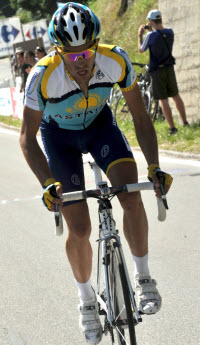 Alberto Contador’s stage win on the mountaintop finish to Verbier, Switzerland on stage 15 of last summer’s Tour de France was one of the cornerstones of the Astana rider’s overall victory. It was where he seized the yellow jersey from previous incumbent Rinaldo Nocentini of Ag2r-La Prevoyance, and where he once and for all confirmed that he was the top dog at the Kazakh sponsored team. It was also the point where a number of commentators said they could prove that he was not all that he seemed. Doctor Roberto Corsetti, in an interview in the November edition of Italian magazine tuttobici, claims that this “proof” is based on inaccurate data.
Alberto Contador’s stage win on the mountaintop finish to Verbier, Switzerland on stage 15 of last summer’s Tour de France was one of the cornerstones of the Astana rider’s overall victory. It was where he seized the yellow jersey from previous incumbent Rinaldo Nocentini of Ag2r-La Prevoyance, and where he once and for all confirmed that he was the top dog at the Kazakh sponsored team. It was also the point where a number of commentators said they could prove that he was not all that he seemed. Doctor Roberto Corsetti, in an interview in the November edition of Italian magazine tuttobici, claims that this “proof” is based on inaccurate data.
Former Festina team trainer – and now ethical cycling coach – Antoine Vayer claimed that for Contador to have climbed the 8.5km to the summit in a time of 20’55” meant an unprecedented VAM (vertical metres climbed per hour) of 1920; this eclipsed the previous record VAM set by Bjarne Riis on Hautacam in 1996, on his way to Tour victory. Riis confessed in May 2007 to using EPO to win that Tour in a press conference saying: "My jersey is at home in a cardboard box. They are welcome to come and get it. I have my memories for myself."
The claim was also made that to achieve this VAM, Contador would need to be producing an incredible 491 Watts on average, at an almost unimaginable 7 Watts per kilo. These figures were quoted by names such as Greg Lemond to criticise Contador, but Corsetti disputes these figures with his new calculations.
Corsetti first calls Vayer’s VAM calculation into doubt, saying that the average gradient used should be more like 7.5% than the 7.9% used, and that the metres climbed was 638 rather than 669 and therefore the VAM was 1830, not 1920. He then introduces factors such as the rider’s drag coefficient, the air density at altitude, the roughness of the road surface, and the tyre pressure and section. Using an estimated combined weight of Contador and his bike and clothing of 72kg he recalculates a total average Wattage of 393; still high, but roughly 20% lower than the figure quoted by Vayer. Corsetti’s Watts per kilo figure is 6.15, which is well within accepted levels.
Corsetti also calls into question the fact that if the figures calculated by Vayer for Contador’s ascent to the finish in Verbier were to be used, other riders had equally – or even more – questionable values; something that he does not accept. Under Vayer’s calculations Andy Schleck climbed with a VAM of 1856 and Vincenzo Nibali with 1828, meaning they produced 486.8 Wattts (7.26 Watts/Kilo) and 460.7 Watts (7.19 Watts/Kilo) respectively. (Schleck and Nibali were second and third on the stage, repsectively)
“Is it useful to continue to want to see what is possible presented as unnatural in light of considerations and data, which, as you see, are questionable and debatable if not clearly incorrect?” Corsetti asks. “Is it not easier and more beneficial to the future of our sport – but above all more accurate and truthful, at least until proven otherwise – to think that Alberto Contador is simply a world-beater?"